Trading Scents: Growth Planning, Funding, and Exit Strategy Analysis
VerifiedAdded on 2023/01/12
|14
|4552
|20
Report
AI Summary
This report analyzes the growth strategies for Trading Scents, a UK-based SME in the perfume industry. It begins with an introduction to growth planning and its importance, followed by an analysis of key considerations for evaluating growth opportunities, including PESTLE and Porter's Generic Model. The report then evaluates growth opportunities using Ansoff's Growth Vector Matrix, focusing on market penetration, product development, market development, and diversification. It assesses potential funding sources, including internal and external options, and discusses the design of a business plan for growth, specifically the launch of 'TS-Organic'. The report also examines succession and exit options, concluding with a summary of the findings and recommendations for Trading Scents to achieve sustainable growth within the UK market.

PLANNING FOR
GROWTH
GROWTH
Paraphrase This Document
Need a fresh take? Get an instant paraphrase of this document with our AI Paraphraser

Table of Contents
INTRODUCTION...........................................................................................................................1
LO 1.................................................................................................................................................1
P1. Analysis of key considerations for evaluating growth opportunities....................................1
P2. Evaluation of opportunities for growth applying Ansoff's Growth Vector Matrix..............4
LO 2.................................................................................................................................................5
P3. Assessment of potential sources of funding available to businesses....................................5
LO 3.................................................................................................................................................7
P4. Designing a Business Plan for growth..................................................................................7
LO 4...............................................................................................................................................10
P5. Evaluation of succession or exit options.............................................................................10
CONCLUSION..............................................................................................................................10
REFERENCES..............................................................................................................................12
INTRODUCTION...........................................................................................................................1
LO 1.................................................................................................................................................1
P1. Analysis of key considerations for evaluating growth opportunities....................................1
P2. Evaluation of opportunities for growth applying Ansoff's Growth Vector Matrix..............4
LO 2.................................................................................................................................................5
P3. Assessment of potential sources of funding available to businesses....................................5
LO 3.................................................................................................................................................7
P4. Designing a Business Plan for growth..................................................................................7
LO 4...............................................................................................................................................10
P5. Evaluation of succession or exit options.............................................................................10
CONCLUSION..............................................................................................................................10
REFERENCES..............................................................................................................................12

INTRODUCTION
Planning for growth is one of the most appropriate and effective areas for a business
which relates with assessment and working towards identification and determination of growth
opportunities. Moreover, it is an essential and crucial element which must be followed by a
social or simulated business in order to ensure effective competitive advantage, along with a
planned and appropriate sustainability within the market in which the firm operates (Innes,
2017).
Hence, in this context, the report below is based on Trading Scents, which is a prominent
SME within the United Kingdom dealing in perfumes. The report in this relation undertakes
analysis of all the key considerations which this company should consider in order to evaluate
the growth opportunities within the UK. Moreover, the report also addresses assessment of
various methods through which organisations access their funding, as well as an insight into its
usage. In addition to this, the assignment also include development of a business plan, along with
detailed communication of how the firm intent to scale up its business. Furthermore, the report
also undertakes assessment of various ways in which the SME could exit the business, along
with several implications of each option.
LO 1
P1. Analysis of key considerations for evaluating growth opportunities
For an SME, it is very crucial that it analyse the market and take into consideration some
effective pointers that are necessary towards evaluating growth opportunities present within the
market for the company.
In this regards, the firm must undertake consideration of its external environment factors,
that would be presenting the opportunities which the company has for growth. Hence for this
purpose, PESTLE Analysis is being used that is reflected below:
Political Factors:
All the aspects related to political situation within a country are taken into consideration
in this factor. As for Trading Scents, the current political scenario of the UK is not very much
favourable, due to the current uncertainties by Brexit. Since it has officially been implemented,
the political uncertainties have enhanced due to negotiations with the European Union. However,
1
Planning for growth is one of the most appropriate and effective areas for a business
which relates with assessment and working towards identification and determination of growth
opportunities. Moreover, it is an essential and crucial element which must be followed by a
social or simulated business in order to ensure effective competitive advantage, along with a
planned and appropriate sustainability within the market in which the firm operates (Innes,
2017).
Hence, in this context, the report below is based on Trading Scents, which is a prominent
SME within the United Kingdom dealing in perfumes. The report in this relation undertakes
analysis of all the key considerations which this company should consider in order to evaluate
the growth opportunities within the UK. Moreover, the report also addresses assessment of
various methods through which organisations access their funding, as well as an insight into its
usage. In addition to this, the assignment also include development of a business plan, along with
detailed communication of how the firm intent to scale up its business. Furthermore, the report
also undertakes assessment of various ways in which the SME could exit the business, along
with several implications of each option.
LO 1
P1. Analysis of key considerations for evaluating growth opportunities
For an SME, it is very crucial that it analyse the market and take into consideration some
effective pointers that are necessary towards evaluating growth opportunities present within the
market for the company.
In this regards, the firm must undertake consideration of its external environment factors,
that would be presenting the opportunities which the company has for growth. Hence for this
purpose, PESTLE Analysis is being used that is reflected below:
Political Factors:
All the aspects related to political situation within a country are taken into consideration
in this factor. As for Trading Scents, the current political scenario of the UK is not very much
favourable, due to the current uncertainties by Brexit. Since it has officially been implemented,
the political uncertainties have enhanced due to negotiations with the European Union. However,
1
⊘ This is a preview!⊘
Do you want full access?
Subscribe today to unlock all pages.

Trusted by 1+ million students worldwide
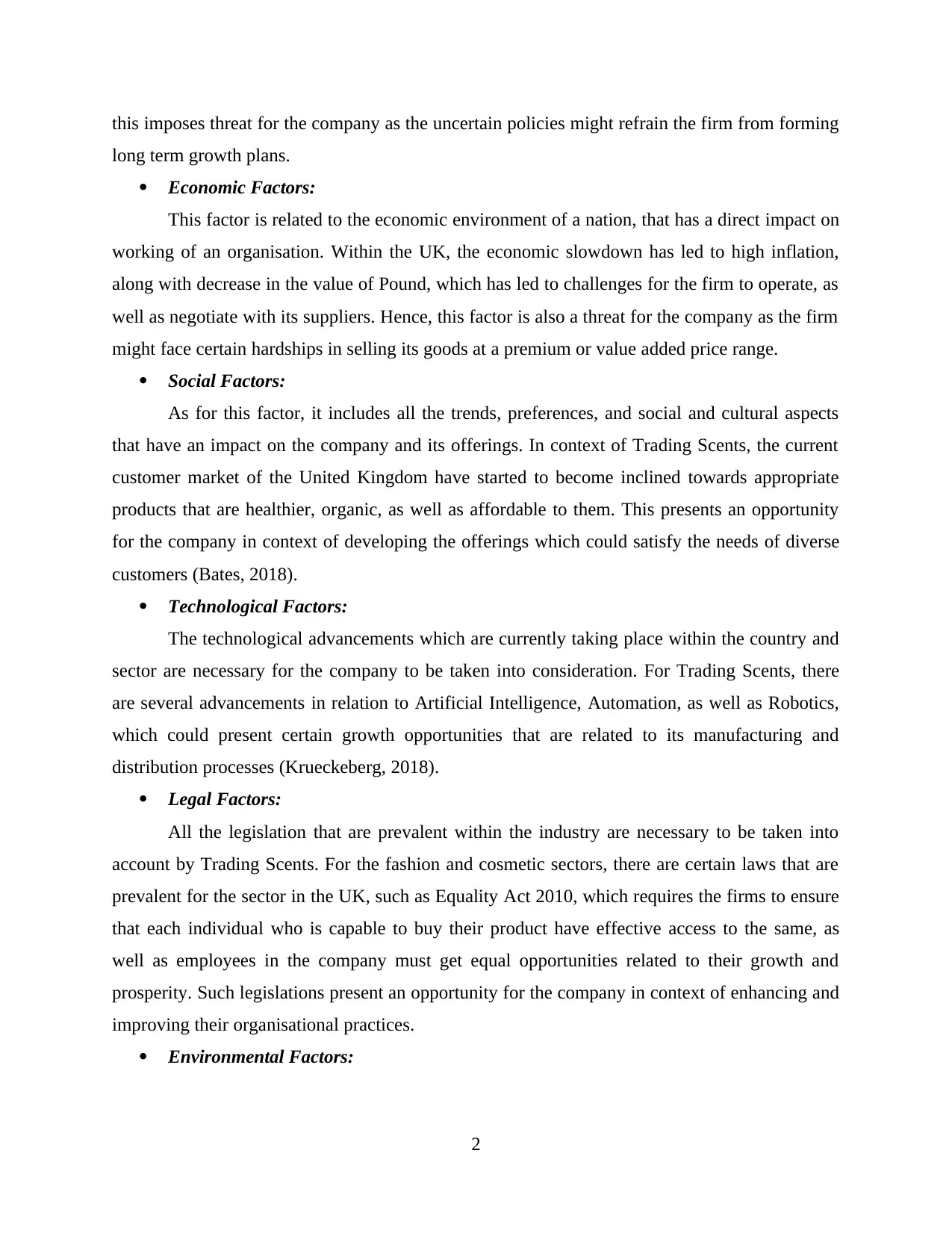
this imposes threat for the company as the uncertain policies might refrain the firm from forming
long term growth plans.
Economic Factors:
This factor is related to the economic environment of a nation, that has a direct impact on
working of an organisation. Within the UK, the economic slowdown has led to high inflation,
along with decrease in the value of Pound, which has led to challenges for the firm to operate, as
well as negotiate with its suppliers. Hence, this factor is also a threat for the company as the firm
might face certain hardships in selling its goods at a premium or value added price range.
Social Factors:
As for this factor, it includes all the trends, preferences, and social and cultural aspects
that have an impact on the company and its offerings. In context of Trading Scents, the current
customer market of the United Kingdom have started to become inclined towards appropriate
products that are healthier, organic, as well as affordable to them. This presents an opportunity
for the company in context of developing the offerings which could satisfy the needs of diverse
customers (Bates, 2018).
Technological Factors:
The technological advancements which are currently taking place within the country and
sector are necessary for the company to be taken into consideration. For Trading Scents, there
are several advancements in relation to Artificial Intelligence, Automation, as well as Robotics,
which could present certain growth opportunities that are related to its manufacturing and
distribution processes (Krueckeberg, 2018).
Legal Factors:
All the legislation that are prevalent within the industry are necessary to be taken into
account by Trading Scents. For the fashion and cosmetic sectors, there are certain laws that are
prevalent for the sector in the UK, such as Equality Act 2010, which requires the firms to ensure
that each individual who is capable to buy their product have effective access to the same, as
well as employees in the company must get equal opportunities related to their growth and
prosperity. Such legislations present an opportunity for the company in context of enhancing and
improving their organisational practices.
Environmental Factors:
2
long term growth plans.
Economic Factors:
This factor is related to the economic environment of a nation, that has a direct impact on
working of an organisation. Within the UK, the economic slowdown has led to high inflation,
along with decrease in the value of Pound, which has led to challenges for the firm to operate, as
well as negotiate with its suppliers. Hence, this factor is also a threat for the company as the firm
might face certain hardships in selling its goods at a premium or value added price range.
Social Factors:
As for this factor, it includes all the trends, preferences, and social and cultural aspects
that have an impact on the company and its offerings. In context of Trading Scents, the current
customer market of the United Kingdom have started to become inclined towards appropriate
products that are healthier, organic, as well as affordable to them. This presents an opportunity
for the company in context of developing the offerings which could satisfy the needs of diverse
customers (Bates, 2018).
Technological Factors:
The technological advancements which are currently taking place within the country and
sector are necessary for the company to be taken into consideration. For Trading Scents, there
are several advancements in relation to Artificial Intelligence, Automation, as well as Robotics,
which could present certain growth opportunities that are related to its manufacturing and
distribution processes (Krueckeberg, 2018).
Legal Factors:
All the legislation that are prevalent within the industry are necessary to be taken into
account by Trading Scents. For the fashion and cosmetic sectors, there are certain laws that are
prevalent for the sector in the UK, such as Equality Act 2010, which requires the firms to ensure
that each individual who is capable to buy their product have effective access to the same, as
well as employees in the company must get equal opportunities related to their growth and
prosperity. Such legislations present an opportunity for the company in context of enhancing and
improving their organisational practices.
Environmental Factors:
2
Paraphrase This Document
Need a fresh take? Get an instant paraphrase of this document with our AI Paraphraser
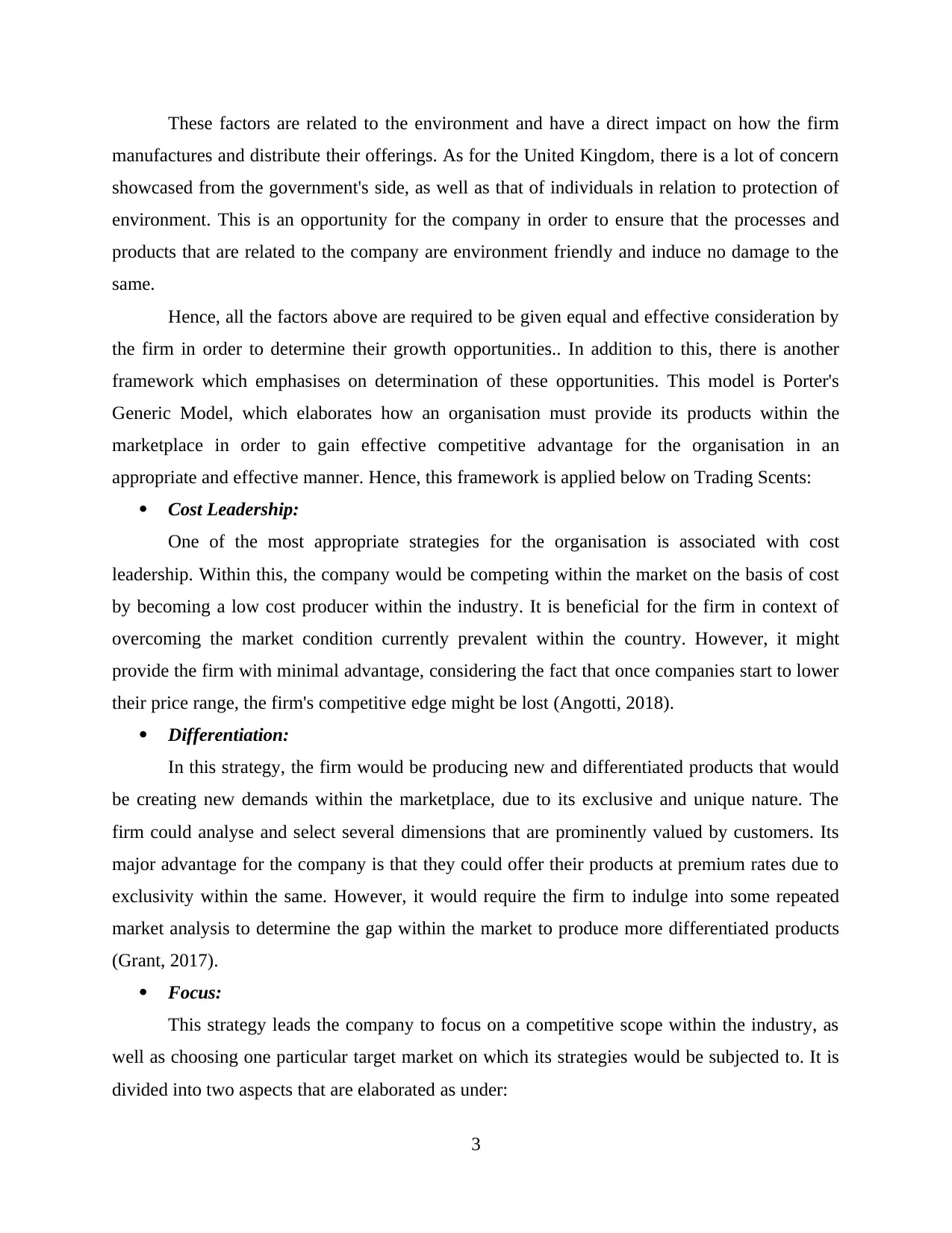
These factors are related to the environment and have a direct impact on how the firm
manufactures and distribute their offerings. As for the United Kingdom, there is a lot of concern
showcased from the government's side, as well as that of individuals in relation to protection of
environment. This is an opportunity for the company in order to ensure that the processes and
products that are related to the company are environment friendly and induce no damage to the
same.
Hence, all the factors above are required to be given equal and effective consideration by
the firm in order to determine their growth opportunities.. In addition to this, there is another
framework which emphasises on determination of these opportunities. This model is Porter's
Generic Model, which elaborates how an organisation must provide its products within the
marketplace in order to gain effective competitive advantage for the organisation in an
appropriate and effective manner. Hence, this framework is applied below on Trading Scents:
Cost Leadership:
One of the most appropriate strategies for the organisation is associated with cost
leadership. Within this, the company would be competing within the market on the basis of cost
by becoming a low cost producer within the industry. It is beneficial for the firm in context of
overcoming the market condition currently prevalent within the country. However, it might
provide the firm with minimal advantage, considering the fact that once companies start to lower
their price range, the firm's competitive edge might be lost (Angotti, 2018).
Differentiation:
In this strategy, the firm would be producing new and differentiated products that would
be creating new demands within the marketplace, due to its exclusive and unique nature. The
firm could analyse and select several dimensions that are prominently valued by customers. Its
major advantage for the company is that they could offer their products at premium rates due to
exclusivity within the same. However, it would require the firm to indulge into some repeated
market analysis to determine the gap within the market to produce more differentiated products
(Grant, 2017).
Focus:
This strategy leads the company to focus on a competitive scope within the industry, as
well as choosing one particular target market on which its strategies would be subjected to. It is
divided into two aspects that are elaborated as under:
3
manufactures and distribute their offerings. As for the United Kingdom, there is a lot of concern
showcased from the government's side, as well as that of individuals in relation to protection of
environment. This is an opportunity for the company in order to ensure that the processes and
products that are related to the company are environment friendly and induce no damage to the
same.
Hence, all the factors above are required to be given equal and effective consideration by
the firm in order to determine their growth opportunities.. In addition to this, there is another
framework which emphasises on determination of these opportunities. This model is Porter's
Generic Model, which elaborates how an organisation must provide its products within the
marketplace in order to gain effective competitive advantage for the organisation in an
appropriate and effective manner. Hence, this framework is applied below on Trading Scents:
Cost Leadership:
One of the most appropriate strategies for the organisation is associated with cost
leadership. Within this, the company would be competing within the market on the basis of cost
by becoming a low cost producer within the industry. It is beneficial for the firm in context of
overcoming the market condition currently prevalent within the country. However, it might
provide the firm with minimal advantage, considering the fact that once companies start to lower
their price range, the firm's competitive edge might be lost (Angotti, 2018).
Differentiation:
In this strategy, the firm would be producing new and differentiated products that would
be creating new demands within the marketplace, due to its exclusive and unique nature. The
firm could analyse and select several dimensions that are prominently valued by customers. Its
major advantage for the company is that they could offer their products at premium rates due to
exclusivity within the same. However, it would require the firm to indulge into some repeated
market analysis to determine the gap within the market to produce more differentiated products
(Grant, 2017).
Focus:
This strategy leads the company to focus on a competitive scope within the industry, as
well as choosing one particular target market on which its strategies would be subjected to. It is
divided into two aspects that are elaborated as under:
3
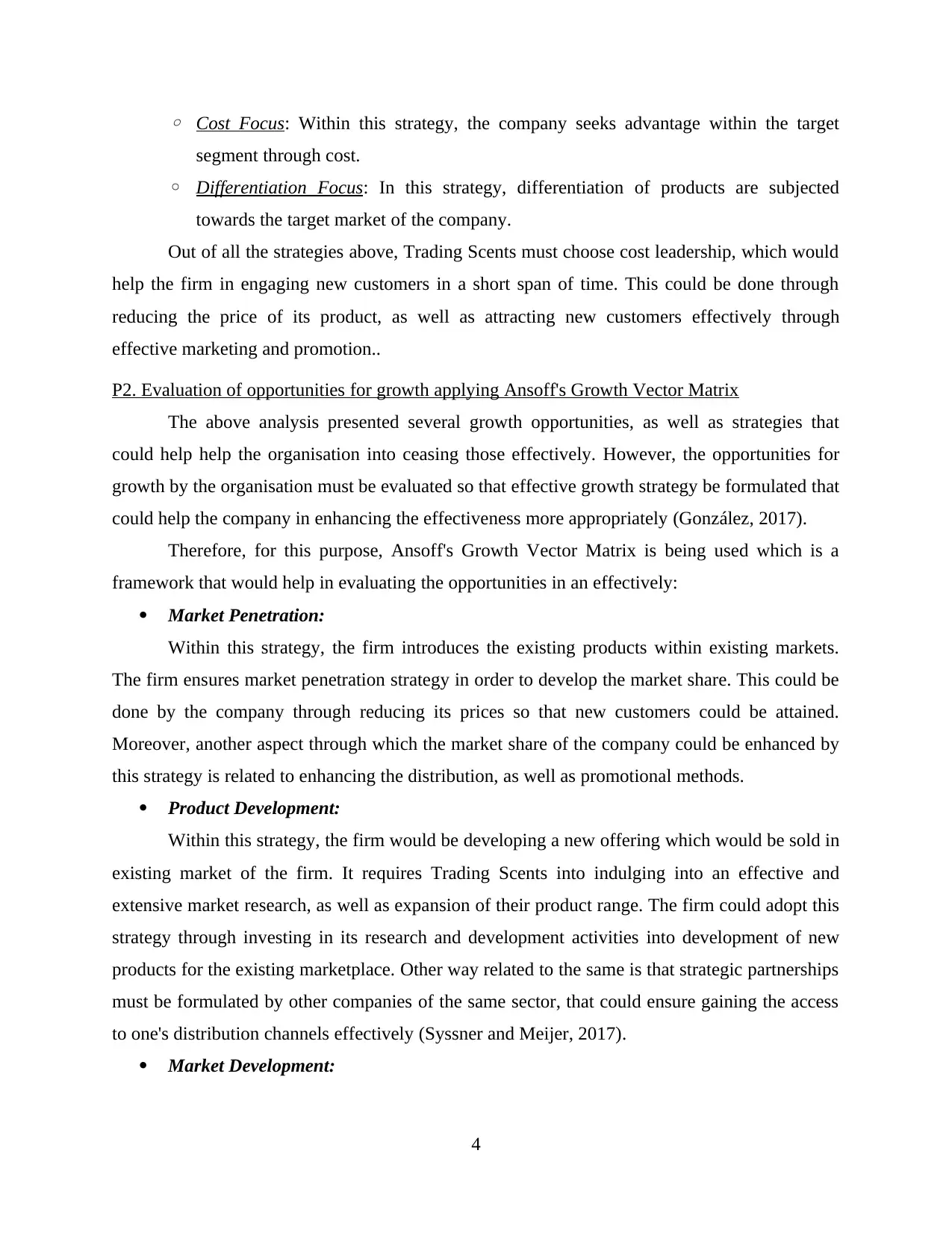
◦ Cost Focus: Within this strategy, the company seeks advantage within the target
segment through cost.
◦ Differentiation Focus: In this strategy, differentiation of products are subjected
towards the target market of the company.
Out of all the strategies above, Trading Scents must choose cost leadership, which would
help the firm in engaging new customers in a short span of time. This could be done through
reducing the price of its product, as well as attracting new customers effectively through
effective marketing and promotion..
P2. Evaluation of opportunities for growth applying Ansoff's Growth Vector Matrix
The above analysis presented several growth opportunities, as well as strategies that
could help help the organisation into ceasing those effectively. However, the opportunities for
growth by the organisation must be evaluated so that effective growth strategy be formulated that
could help the company in enhancing the effectiveness more appropriately (González, 2017).
Therefore, for this purpose, Ansoff's Growth Vector Matrix is being used which is a
framework that would help in evaluating the opportunities in an effectively:
Market Penetration:
Within this strategy, the firm introduces the existing products within existing markets.
The firm ensures market penetration strategy in order to develop the market share. This could be
done by the company through reducing its prices so that new customers could be attained.
Moreover, another aspect through which the market share of the company could be enhanced by
this strategy is related to enhancing the distribution, as well as promotional methods.
Product Development:
Within this strategy, the firm would be developing a new offering which would be sold in
existing market of the firm. It requires Trading Scents into indulging into an effective and
extensive market research, as well as expansion of their product range. The firm could adopt this
strategy through investing in its research and development activities into development of new
products for the existing marketplace. Other way related to the same is that strategic partnerships
must be formulated by other companies of the same sector, that could ensure gaining the access
to one's distribution channels effectively (Syssner and Meijer, 2017).
Market Development:
4
segment through cost.
◦ Differentiation Focus: In this strategy, differentiation of products are subjected
towards the target market of the company.
Out of all the strategies above, Trading Scents must choose cost leadership, which would
help the firm in engaging new customers in a short span of time. This could be done through
reducing the price of its product, as well as attracting new customers effectively through
effective marketing and promotion..
P2. Evaluation of opportunities for growth applying Ansoff's Growth Vector Matrix
The above analysis presented several growth opportunities, as well as strategies that
could help help the organisation into ceasing those effectively. However, the opportunities for
growth by the organisation must be evaluated so that effective growth strategy be formulated that
could help the company in enhancing the effectiveness more appropriately (González, 2017).
Therefore, for this purpose, Ansoff's Growth Vector Matrix is being used which is a
framework that would help in evaluating the opportunities in an effectively:
Market Penetration:
Within this strategy, the firm introduces the existing products within existing markets.
The firm ensures market penetration strategy in order to develop the market share. This could be
done by the company through reducing its prices so that new customers could be attained.
Moreover, another aspect through which the market share of the company could be enhanced by
this strategy is related to enhancing the distribution, as well as promotional methods.
Product Development:
Within this strategy, the firm would be developing a new offering which would be sold in
existing market of the firm. It requires Trading Scents into indulging into an effective and
extensive market research, as well as expansion of their product range. The firm could adopt this
strategy through investing in its research and development activities into development of new
products for the existing marketplace. Other way related to the same is that strategic partnerships
must be formulated by other companies of the same sector, that could ensure gaining the access
to one's distribution channels effectively (Syssner and Meijer, 2017).
Market Development:
4
⊘ This is a preview!⊘
Do you want full access?
Subscribe today to unlock all pages.

Trusted by 1+ million students worldwide
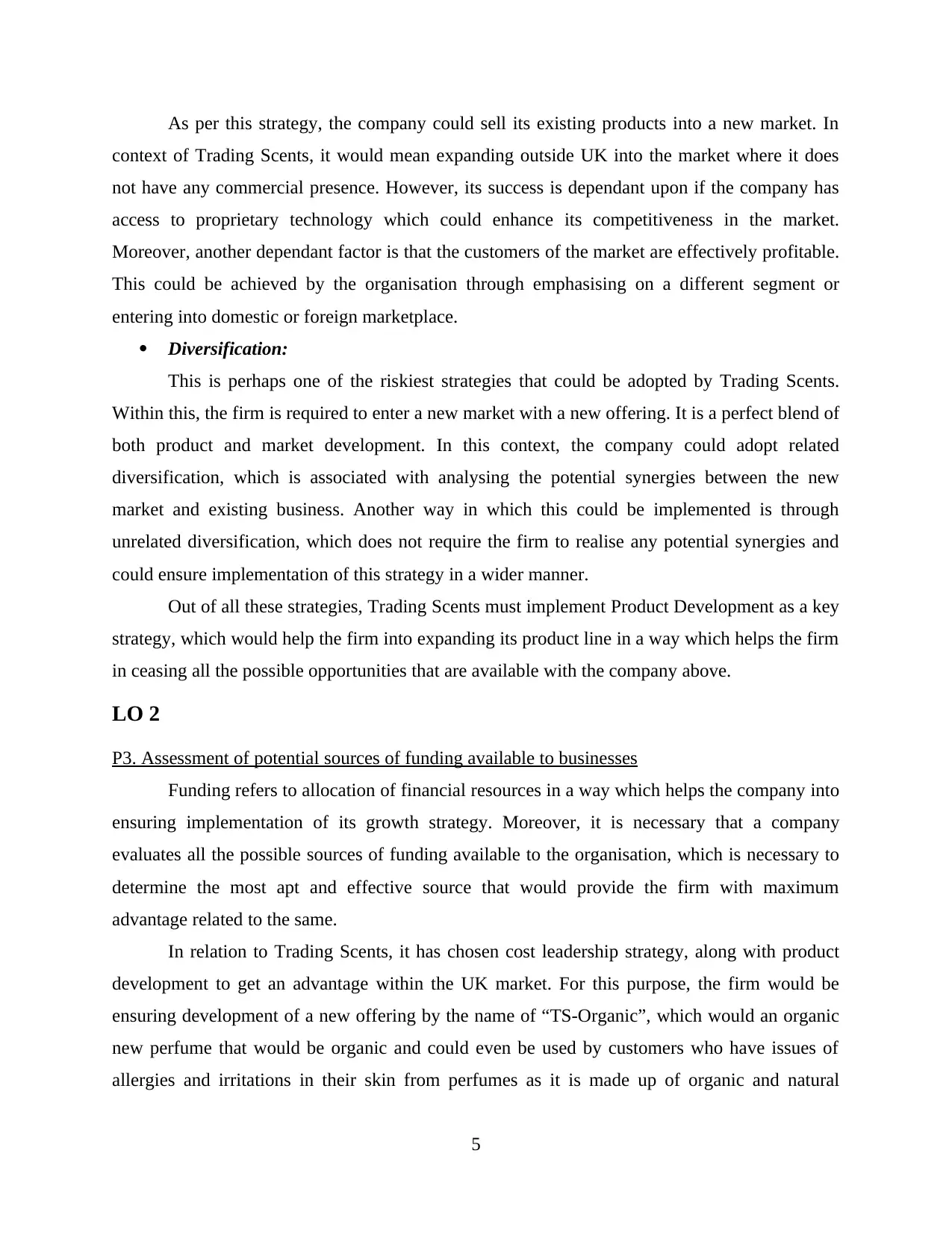
As per this strategy, the company could sell its existing products into a new market. In
context of Trading Scents, it would mean expanding outside UK into the market where it does
not have any commercial presence. However, its success is dependant upon if the company has
access to proprietary technology which could enhance its competitiveness in the market.
Moreover, another dependant factor is that the customers of the market are effectively profitable.
This could be achieved by the organisation through emphasising on a different segment or
entering into domestic or foreign marketplace.
Diversification:
This is perhaps one of the riskiest strategies that could be adopted by Trading Scents.
Within this, the firm is required to enter a new market with a new offering. It is a perfect blend of
both product and market development. In this context, the company could adopt related
diversification, which is associated with analysing the potential synergies between the new
market and existing business. Another way in which this could be implemented is through
unrelated diversification, which does not require the firm to realise any potential synergies and
could ensure implementation of this strategy in a wider manner.
Out of all these strategies, Trading Scents must implement Product Development as a key
strategy, which would help the firm into expanding its product line in a way which helps the firm
in ceasing all the possible opportunities that are available with the company above.
LO 2
P3. Assessment of potential sources of funding available to businesses
Funding refers to allocation of financial resources in a way which helps the company into
ensuring implementation of its growth strategy. Moreover, it is necessary that a company
evaluates all the possible sources of funding available to the organisation, which is necessary to
determine the most apt and effective source that would provide the firm with maximum
advantage related to the same.
In relation to Trading Scents, it has chosen cost leadership strategy, along with product
development to get an advantage within the UK market. For this purpose, the firm would be
ensuring development of a new offering by the name of “TS-Organic”, which would an organic
new perfume that would be organic and could even be used by customers who have issues of
allergies and irritations in their skin from perfumes as it is made up of organic and natural
5
context of Trading Scents, it would mean expanding outside UK into the market where it does
not have any commercial presence. However, its success is dependant upon if the company has
access to proprietary technology which could enhance its competitiveness in the market.
Moreover, another dependant factor is that the customers of the market are effectively profitable.
This could be achieved by the organisation through emphasising on a different segment or
entering into domestic or foreign marketplace.
Diversification:
This is perhaps one of the riskiest strategies that could be adopted by Trading Scents.
Within this, the firm is required to enter a new market with a new offering. It is a perfect blend of
both product and market development. In this context, the company could adopt related
diversification, which is associated with analysing the potential synergies between the new
market and existing business. Another way in which this could be implemented is through
unrelated diversification, which does not require the firm to realise any potential synergies and
could ensure implementation of this strategy in a wider manner.
Out of all these strategies, Trading Scents must implement Product Development as a key
strategy, which would help the firm into expanding its product line in a way which helps the firm
in ceasing all the possible opportunities that are available with the company above.
LO 2
P3. Assessment of potential sources of funding available to businesses
Funding refers to allocation of financial resources in a way which helps the company into
ensuring implementation of its growth strategy. Moreover, it is necessary that a company
evaluates all the possible sources of funding available to the organisation, which is necessary to
determine the most apt and effective source that would provide the firm with maximum
advantage related to the same.
In relation to Trading Scents, it has chosen cost leadership strategy, along with product
development to get an advantage within the UK market. For this purpose, the firm would be
ensuring development of a new offering by the name of “TS-Organic”, which would an organic
new perfume that would be organic and could even be used by customers who have issues of
allergies and irritations in their skin from perfumes as it is made up of organic and natural
5
Paraphrase This Document
Need a fresh take? Get an instant paraphrase of this document with our AI Paraphraser
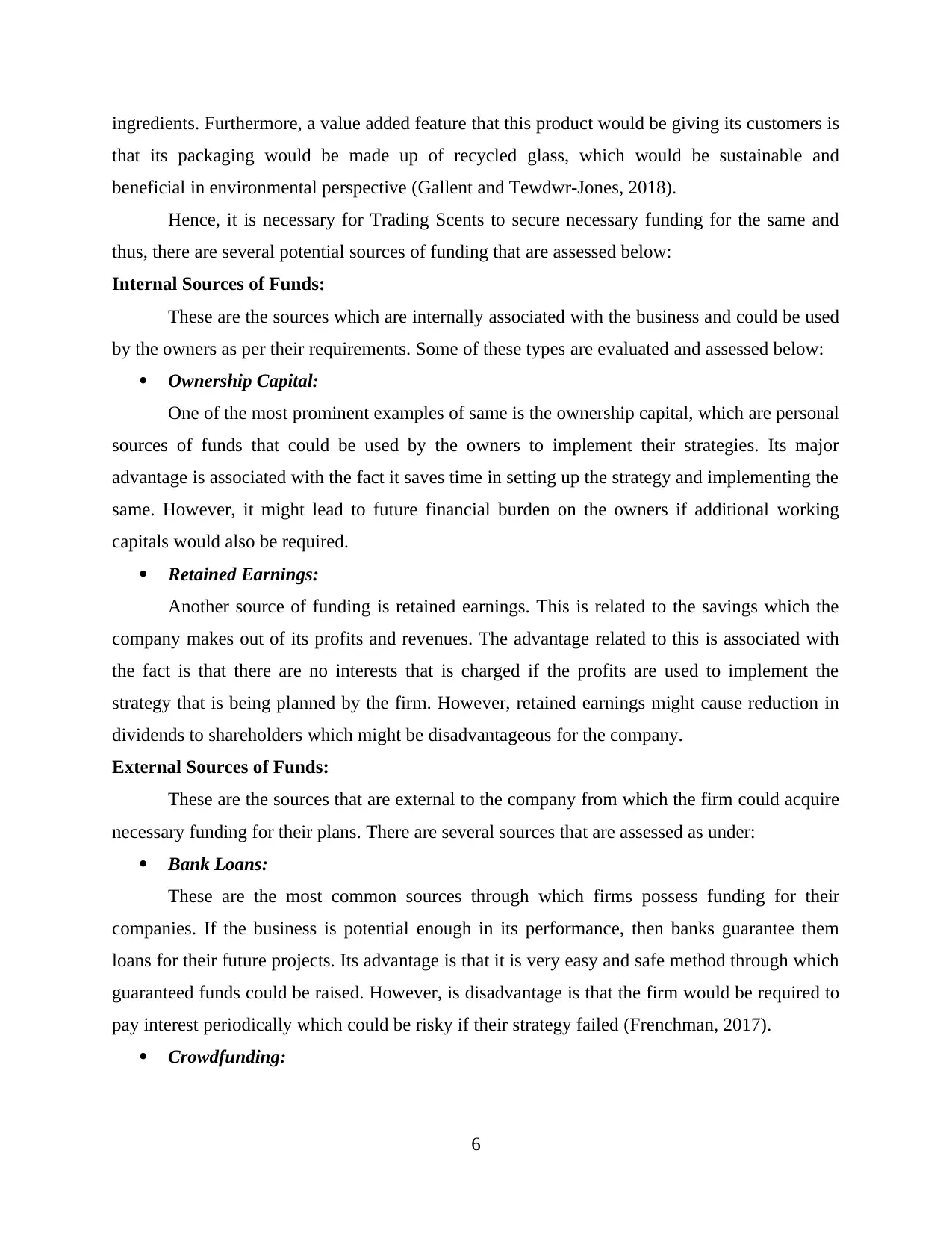
ingredients. Furthermore, a value added feature that this product would be giving its customers is
that its packaging would be made up of recycled glass, which would be sustainable and
beneficial in environmental perspective (Gallent and Tewdwr-Jones, 2018).
Hence, it is necessary for Trading Scents to secure necessary funding for the same and
thus, there are several potential sources of funding that are assessed below:
Internal Sources of Funds:
These are the sources which are internally associated with the business and could be used
by the owners as per their requirements. Some of these types are evaluated and assessed below:
Ownership Capital:
One of the most prominent examples of same is the ownership capital, which are personal
sources of funds that could be used by the owners to implement their strategies. Its major
advantage is associated with the fact it saves time in setting up the strategy and implementing the
same. However, it might lead to future financial burden on the owners if additional working
capitals would also be required.
Retained Earnings:
Another source of funding is retained earnings. This is related to the savings which the
company makes out of its profits and revenues. The advantage related to this is associated with
the fact is that there are no interests that is charged if the profits are used to implement the
strategy that is being planned by the firm. However, retained earnings might cause reduction in
dividends to shareholders which might be disadvantageous for the company.
External Sources of Funds:
These are the sources that are external to the company from which the firm could acquire
necessary funding for their plans. There are several sources that are assessed as under:
Bank Loans:
These are the most common sources through which firms possess funding for their
companies. If the business is potential enough in its performance, then banks guarantee them
loans for their future projects. Its advantage is that it is very easy and safe method through which
guaranteed funds could be raised. However, is disadvantage is that the firm would be required to
pay interest periodically which could be risky if their strategy failed (Frenchman, 2017).
Crowdfunding:
6
that its packaging would be made up of recycled glass, which would be sustainable and
beneficial in environmental perspective (Gallent and Tewdwr-Jones, 2018).
Hence, it is necessary for Trading Scents to secure necessary funding for the same and
thus, there are several potential sources of funding that are assessed below:
Internal Sources of Funds:
These are the sources which are internally associated with the business and could be used
by the owners as per their requirements. Some of these types are evaluated and assessed below:
Ownership Capital:
One of the most prominent examples of same is the ownership capital, which are personal
sources of funds that could be used by the owners to implement their strategies. Its major
advantage is associated with the fact it saves time in setting up the strategy and implementing the
same. However, it might lead to future financial burden on the owners if additional working
capitals would also be required.
Retained Earnings:
Another source of funding is retained earnings. This is related to the savings which the
company makes out of its profits and revenues. The advantage related to this is associated with
the fact is that there are no interests that is charged if the profits are used to implement the
strategy that is being planned by the firm. However, retained earnings might cause reduction in
dividends to shareholders which might be disadvantageous for the company.
External Sources of Funds:
These are the sources that are external to the company from which the firm could acquire
necessary funding for their plans. There are several sources that are assessed as under:
Bank Loans:
These are the most common sources through which firms possess funding for their
companies. If the business is potential enough in its performance, then banks guarantee them
loans for their future projects. Its advantage is that it is very easy and safe method through which
guaranteed funds could be raised. However, is disadvantage is that the firm would be required to
pay interest periodically which could be risky if their strategy failed (Frenchman, 2017).
Crowdfunding:
6
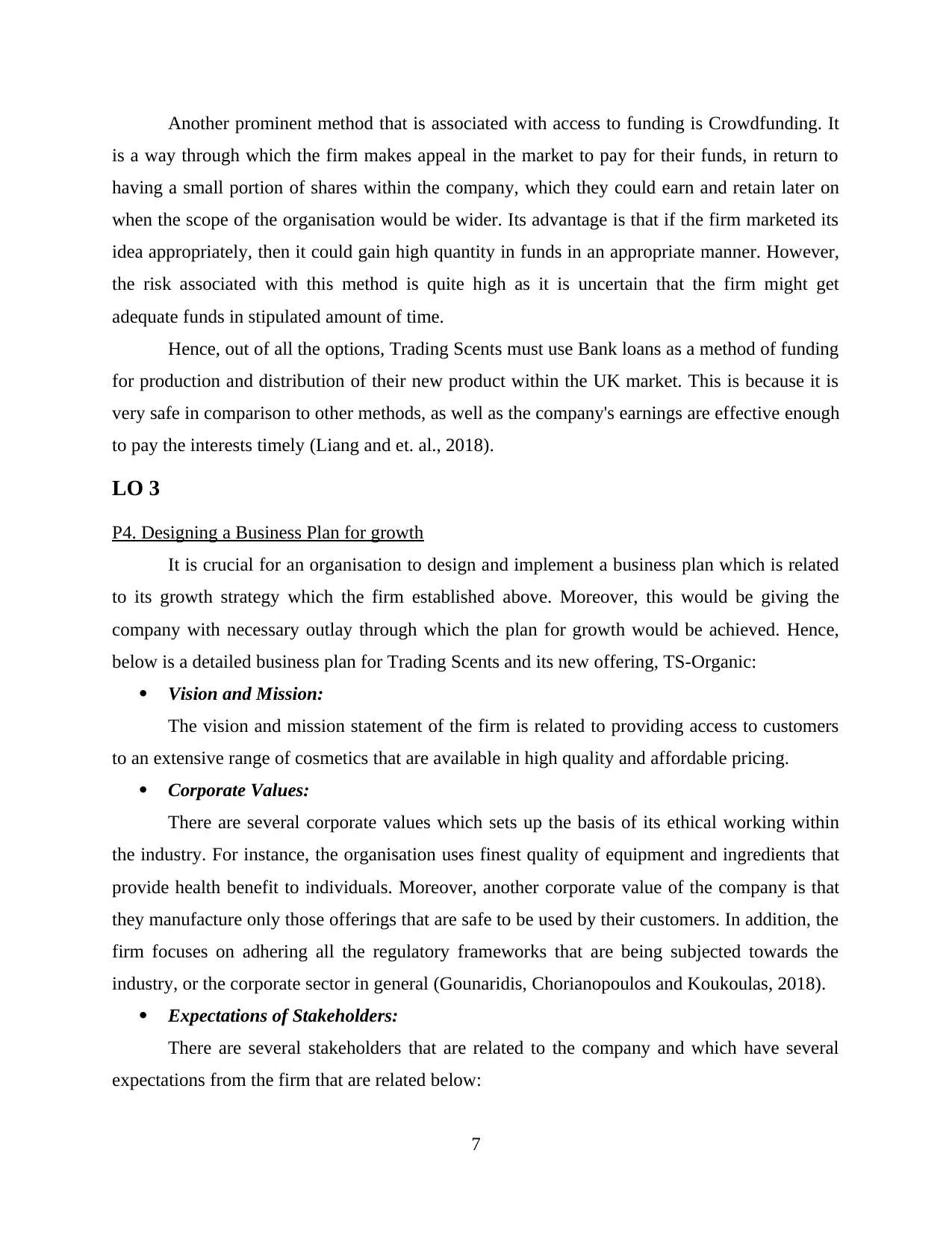
Another prominent method that is associated with access to funding is Crowdfunding. It
is a way through which the firm makes appeal in the market to pay for their funds, in return to
having a small portion of shares within the company, which they could earn and retain later on
when the scope of the organisation would be wider. Its advantage is that if the firm marketed its
idea appropriately, then it could gain high quantity in funds in an appropriate manner. However,
the risk associated with this method is quite high as it is uncertain that the firm might get
adequate funds in stipulated amount of time.
Hence, out of all the options, Trading Scents must use Bank loans as a method of funding
for production and distribution of their new product within the UK market. This is because it is
very safe in comparison to other methods, as well as the company's earnings are effective enough
to pay the interests timely (Liang and et. al., 2018).
LO 3
P4. Designing a Business Plan for growth
It is crucial for an organisation to design and implement a business plan which is related
to its growth strategy which the firm established above. Moreover, this would be giving the
company with necessary outlay through which the plan for growth would be achieved. Hence,
below is a detailed business plan for Trading Scents and its new offering, TS-Organic:
Vision and Mission:
The vision and mission statement of the firm is related to providing access to customers
to an extensive range of cosmetics that are available in high quality and affordable pricing.
Corporate Values:
There are several corporate values which sets up the basis of its ethical working within
the industry. For instance, the organisation uses finest quality of equipment and ingredients that
provide health benefit to individuals. Moreover, another corporate value of the company is that
they manufacture only those offerings that are safe to be used by their customers. In addition, the
firm focuses on adhering all the regulatory frameworks that are being subjected towards the
industry, or the corporate sector in general (Gounaridis, Chorianopoulos and Koukoulas, 2018).
Expectations of Stakeholders:
There are several stakeholders that are related to the company and which have several
expectations from the firm that are related below:
7
is a way through which the firm makes appeal in the market to pay for their funds, in return to
having a small portion of shares within the company, which they could earn and retain later on
when the scope of the organisation would be wider. Its advantage is that if the firm marketed its
idea appropriately, then it could gain high quantity in funds in an appropriate manner. However,
the risk associated with this method is quite high as it is uncertain that the firm might get
adequate funds in stipulated amount of time.
Hence, out of all the options, Trading Scents must use Bank loans as a method of funding
for production and distribution of their new product within the UK market. This is because it is
very safe in comparison to other methods, as well as the company's earnings are effective enough
to pay the interests timely (Liang and et. al., 2018).
LO 3
P4. Designing a Business Plan for growth
It is crucial for an organisation to design and implement a business plan which is related
to its growth strategy which the firm established above. Moreover, this would be giving the
company with necessary outlay through which the plan for growth would be achieved. Hence,
below is a detailed business plan for Trading Scents and its new offering, TS-Organic:
Vision and Mission:
The vision and mission statement of the firm is related to providing access to customers
to an extensive range of cosmetics that are available in high quality and affordable pricing.
Corporate Values:
There are several corporate values which sets up the basis of its ethical working within
the industry. For instance, the organisation uses finest quality of equipment and ingredients that
provide health benefit to individuals. Moreover, another corporate value of the company is that
they manufacture only those offerings that are safe to be used by their customers. In addition, the
firm focuses on adhering all the regulatory frameworks that are being subjected towards the
industry, or the corporate sector in general (Gounaridis, Chorianopoulos and Koukoulas, 2018).
Expectations of Stakeholders:
There are several stakeholders that are related to the company and which have several
expectations from the firm that are related below:
7
⊘ This is a preview!⊘
Do you want full access?
Subscribe today to unlock all pages.

Trusted by 1+ million students worldwide
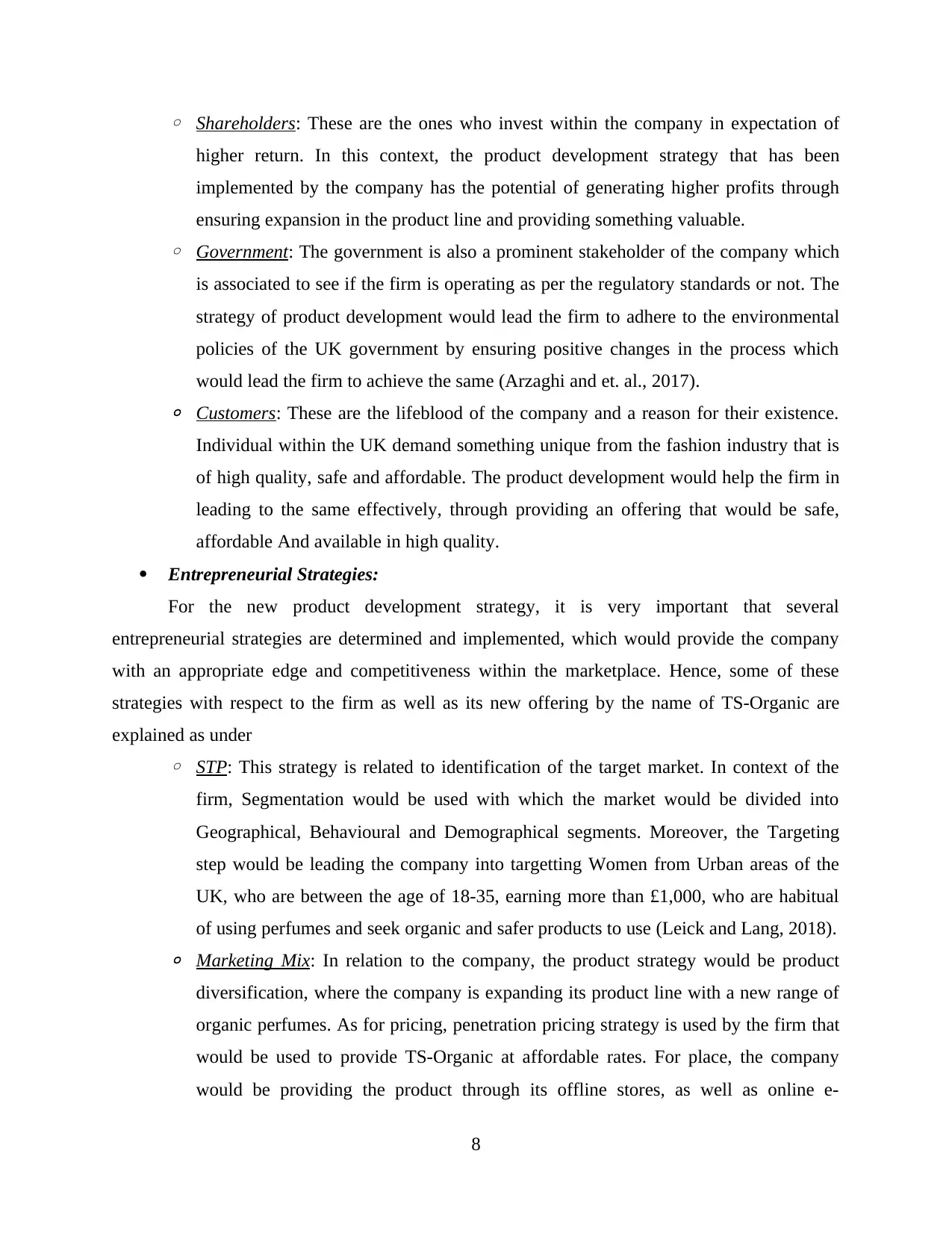
◦ Shareholders: These are the ones who invest within the company in expectation of
higher return. In this context, the product development strategy that has been
implemented by the company has the potential of generating higher profits through
ensuring expansion in the product line and providing something valuable.
◦ Government: The government is also a prominent stakeholder of the company which
is associated to see if the firm is operating as per the regulatory standards or not. The
strategy of product development would lead the firm to adhere to the environmental
policies of the UK government by ensuring positive changes in the process which
would lead the firm to achieve the same (Arzaghi and et. al., 2017).
◦ Customers: These are the lifeblood of the company and a reason for their existence.
Individual within the UK demand something unique from the fashion industry that is
of high quality, safe and affordable. The product development would help the firm in
leading to the same effectively, through providing an offering that would be safe,
affordable And available in high quality.
Entrepreneurial Strategies:
For the new product development strategy, it is very important that several
entrepreneurial strategies are determined and implemented, which would provide the company
with an appropriate edge and competitiveness within the marketplace. Hence, some of these
strategies with respect to the firm as well as its new offering by the name of TS-Organic are
explained as under
◦ STP: This strategy is related to identification of the target market. In context of the
firm, Segmentation would be used with which the market would be divided into
Geographical, Behavioural and Demographical segments. Moreover, the Targeting
step would be leading the company into targetting Women from Urban areas of the
UK, who are between the age of 18-35, earning more than £1,000, who are habitual
of using perfumes and seek organic and safer products to use (Leick and Lang, 2018).
◦ Marketing Mix: In relation to the company, the product strategy would be product
diversification, where the company is expanding its product line with a new range of
organic perfumes. As for pricing, penetration pricing strategy is used by the firm that
would be used to provide TS-Organic at affordable rates. For place, the company
would be providing the product through its offline stores, as well as online e-
8
higher return. In this context, the product development strategy that has been
implemented by the company has the potential of generating higher profits through
ensuring expansion in the product line and providing something valuable.
◦ Government: The government is also a prominent stakeholder of the company which
is associated to see if the firm is operating as per the regulatory standards or not. The
strategy of product development would lead the firm to adhere to the environmental
policies of the UK government by ensuring positive changes in the process which
would lead the firm to achieve the same (Arzaghi and et. al., 2017).
◦ Customers: These are the lifeblood of the company and a reason for their existence.
Individual within the UK demand something unique from the fashion industry that is
of high quality, safe and affordable. The product development would help the firm in
leading to the same effectively, through providing an offering that would be safe,
affordable And available in high quality.
Entrepreneurial Strategies:
For the new product development strategy, it is very important that several
entrepreneurial strategies are determined and implemented, which would provide the company
with an appropriate edge and competitiveness within the marketplace. Hence, some of these
strategies with respect to the firm as well as its new offering by the name of TS-Organic are
explained as under
◦ STP: This strategy is related to identification of the target market. In context of the
firm, Segmentation would be used with which the market would be divided into
Geographical, Behavioural and Demographical segments. Moreover, the Targeting
step would be leading the company into targetting Women from Urban areas of the
UK, who are between the age of 18-35, earning more than £1,000, who are habitual
of using perfumes and seek organic and safer products to use (Leick and Lang, 2018).
◦ Marketing Mix: In relation to the company, the product strategy would be product
diversification, where the company is expanding its product line with a new range of
organic perfumes. As for pricing, penetration pricing strategy is used by the firm that
would be used to provide TS-Organic at affordable rates. For place, the company
would be providing the product through its offline stores, as well as online e-
8
Paraphrase This Document
Need a fresh take? Get an instant paraphrase of this document with our AI Paraphraser
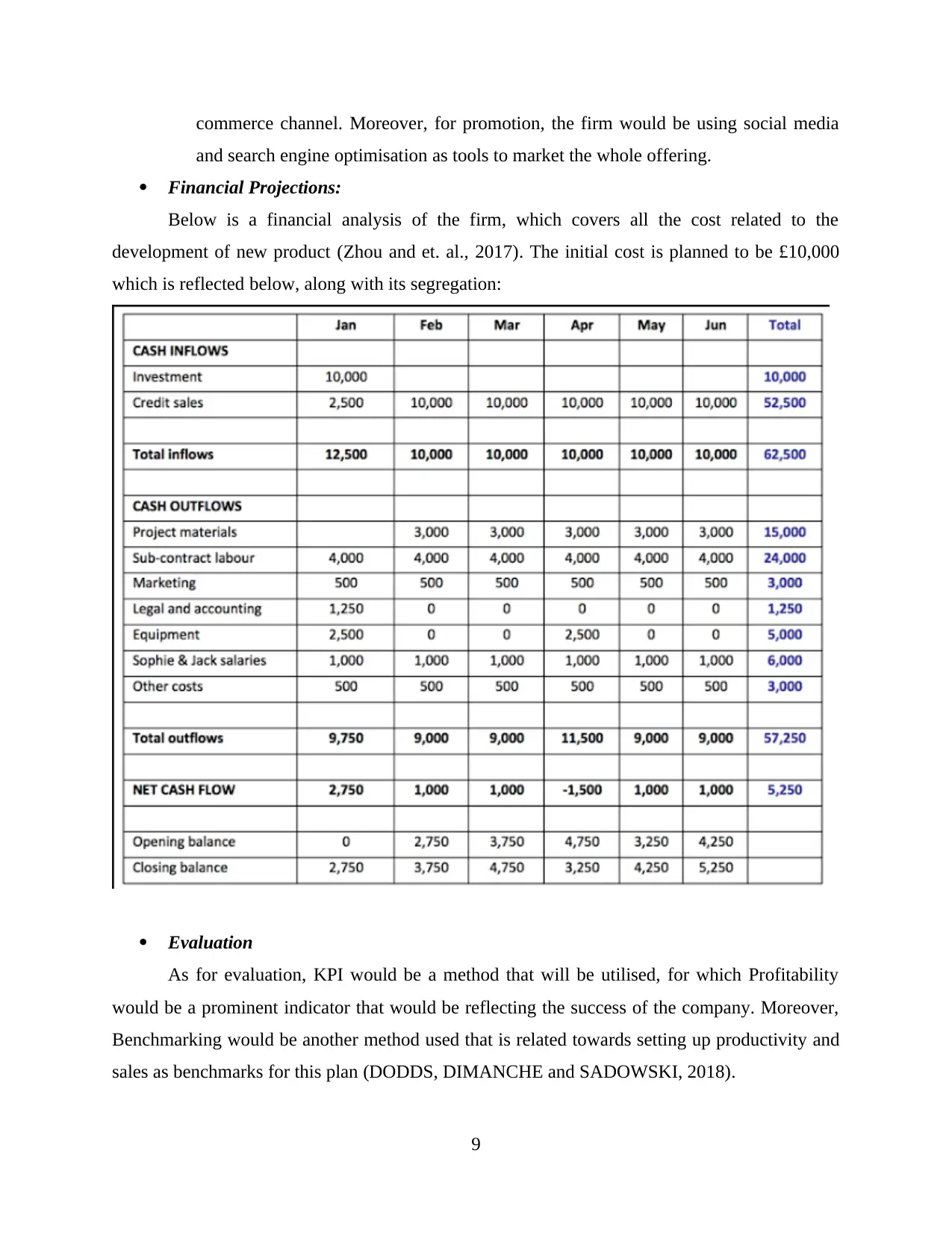
commerce channel. Moreover, for promotion, the firm would be using social media
and search engine optimisation as tools to market the whole offering.
Financial Projections:
Below is a financial analysis of the firm, which covers all the cost related to the
development of new product (Zhou and et. al., 2017). The initial cost is planned to be £10,000
which is reflected below, along with its segregation:
Evaluation
As for evaluation, KPI would be a method that will be utilised, for which Profitability
would be a prominent indicator that would be reflecting the success of the company. Moreover,
Benchmarking would be another method used that is related towards setting up productivity and
sales as benchmarks for this plan (DODDS, DIMANCHE and SADOWSKI, 2018).
9
and search engine optimisation as tools to market the whole offering.
Financial Projections:
Below is a financial analysis of the firm, which covers all the cost related to the
development of new product (Zhou and et. al., 2017). The initial cost is planned to be £10,000
which is reflected below, along with its segregation:
Evaluation
As for evaluation, KPI would be a method that will be utilised, for which Profitability
would be a prominent indicator that would be reflecting the success of the company. Moreover,
Benchmarking would be another method used that is related towards setting up productivity and
sales as benchmarks for this plan (DODDS, DIMANCHE and SADOWSKI, 2018).
9
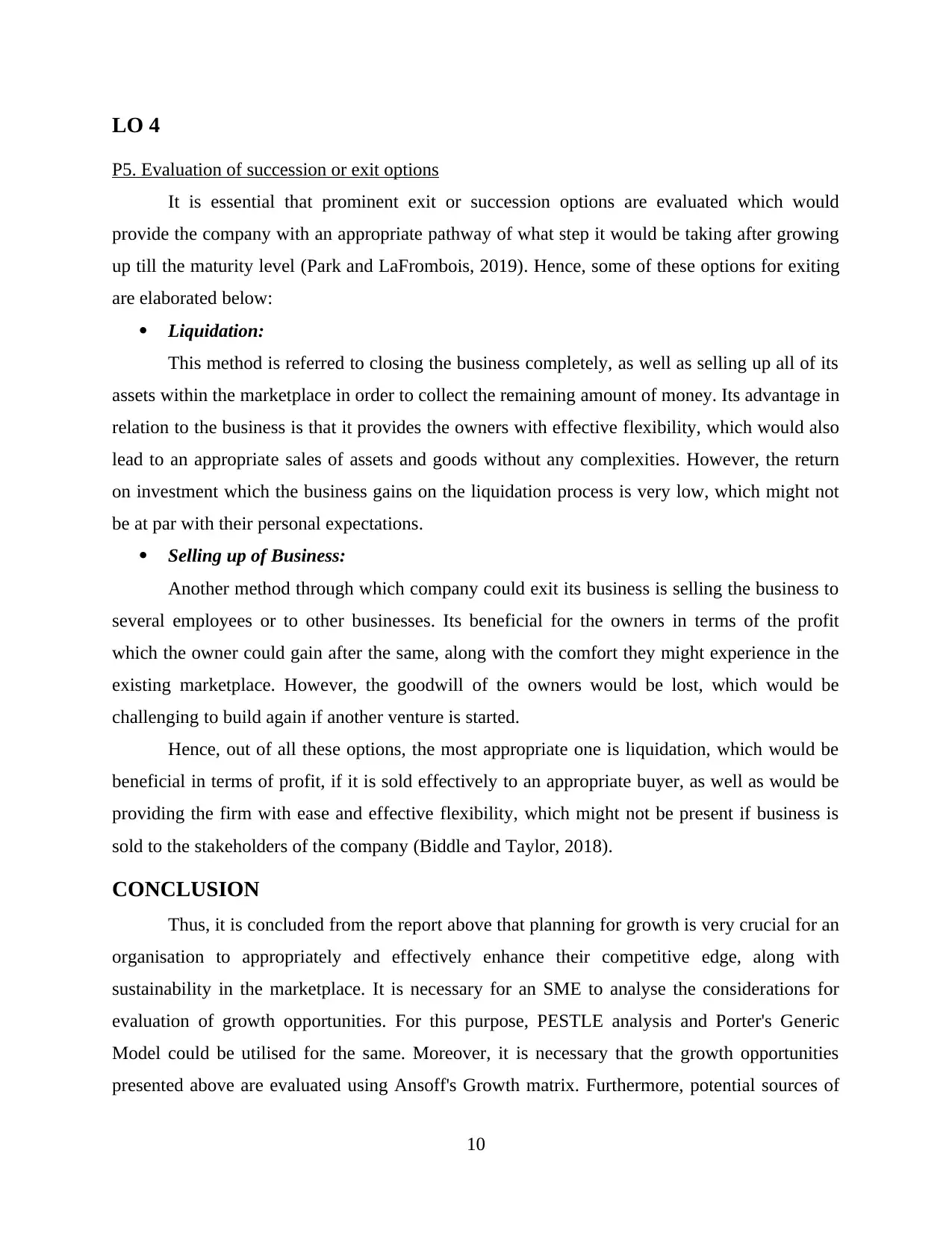
LO 4
P5. Evaluation of succession or exit options
It is essential that prominent exit or succession options are evaluated which would
provide the company with an appropriate pathway of what step it would be taking after growing
up till the maturity level (Park and LaFrombois, 2019). Hence, some of these options for exiting
are elaborated below:
Liquidation:
This method is referred to closing the business completely, as well as selling up all of its
assets within the marketplace in order to collect the remaining amount of money. Its advantage in
relation to the business is that it provides the owners with effective flexibility, which would also
lead to an appropriate sales of assets and goods without any complexities. However, the return
on investment which the business gains on the liquidation process is very low, which might not
be at par with their personal expectations.
Selling up of Business:
Another method through which company could exit its business is selling the business to
several employees or to other businesses. Its beneficial for the owners in terms of the profit
which the owner could gain after the same, along with the comfort they might experience in the
existing marketplace. However, the goodwill of the owners would be lost, which would be
challenging to build again if another venture is started.
Hence, out of all these options, the most appropriate one is liquidation, which would be
beneficial in terms of profit, if it is sold effectively to an appropriate buyer, as well as would be
providing the firm with ease and effective flexibility, which might not be present if business is
sold to the stakeholders of the company (Biddle and Taylor, 2018).
CONCLUSION
Thus, it is concluded from the report above that planning for growth is very crucial for an
organisation to appropriately and effectively enhance their competitive edge, along with
sustainability in the marketplace. It is necessary for an SME to analyse the considerations for
evaluation of growth opportunities. For this purpose, PESTLE analysis and Porter's Generic
Model could be utilised for the same. Moreover, it is necessary that the growth opportunities
presented above are evaluated using Ansoff's Growth matrix. Furthermore, potential sources of
10
P5. Evaluation of succession or exit options
It is essential that prominent exit or succession options are evaluated which would
provide the company with an appropriate pathway of what step it would be taking after growing
up till the maturity level (Park and LaFrombois, 2019). Hence, some of these options for exiting
are elaborated below:
Liquidation:
This method is referred to closing the business completely, as well as selling up all of its
assets within the marketplace in order to collect the remaining amount of money. Its advantage in
relation to the business is that it provides the owners with effective flexibility, which would also
lead to an appropriate sales of assets and goods without any complexities. However, the return
on investment which the business gains on the liquidation process is very low, which might not
be at par with their personal expectations.
Selling up of Business:
Another method through which company could exit its business is selling the business to
several employees or to other businesses. Its beneficial for the owners in terms of the profit
which the owner could gain after the same, along with the comfort they might experience in the
existing marketplace. However, the goodwill of the owners would be lost, which would be
challenging to build again if another venture is started.
Hence, out of all these options, the most appropriate one is liquidation, which would be
beneficial in terms of profit, if it is sold effectively to an appropriate buyer, as well as would be
providing the firm with ease and effective flexibility, which might not be present if business is
sold to the stakeholders of the company (Biddle and Taylor, 2018).
CONCLUSION
Thus, it is concluded from the report above that planning for growth is very crucial for an
organisation to appropriately and effectively enhance their competitive edge, along with
sustainability in the marketplace. It is necessary for an SME to analyse the considerations for
evaluation of growth opportunities. For this purpose, PESTLE analysis and Porter's Generic
Model could be utilised for the same. Moreover, it is necessary that the growth opportunities
presented above are evaluated using Ansoff's Growth matrix. Furthermore, potential sources of
10
⊘ This is a preview!⊘
Do you want full access?
Subscribe today to unlock all pages.

Trusted by 1+ million students worldwide
1 out of 14
Related Documents
Your All-in-One AI-Powered Toolkit for Academic Success.
+13062052269
info@desklib.com
Available 24*7 on WhatsApp / Email
![[object Object]](/_next/static/media/star-bottom.7253800d.svg)
Unlock your academic potential
Copyright © 2020–2025 A2Z Services. All Rights Reserved. Developed and managed by ZUCOL.




